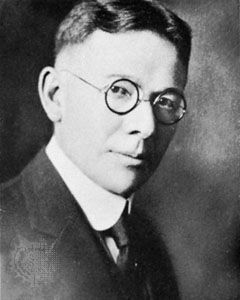On January 15, 1877, American psychologist Lewis Madison Terman was born. He is best known for his pioneering work in individual intelligence tests as well as for his revision of the Stanford-Binet IQ test, with which he introduced the IQ (Intelligence Quotient), being a ratio of chronological age to mental age times 100.
Lewis Terman Background
Lewis Terman was raised on a farm became a school teacher as well as high school principal in his early career. Terman received his doctorate in psychology from Clark University in 1905 though suffering from tuberculosis, a disease that bothered him occasionally for many years. Advised to seek a mild climate, Terman limited his search for a position to the South and Southwest.[8] After high school affiliations in Florida, Texas and California, his health improved steadily so that in 1910, when he had the opportunity to come to Stanford as Professor of Educational Psychology in the then Department of Education, he was physically able to embark on the rigorous work schedule he was to follow most of his remaining years.He served as chairman of the psychology department from 1922 to 1945.
The Intelligence Quotient
In his research, Terman focused on mental testing while revising Alfred Binet’s scale of intelligence [3]. It was published in 1916 as the famous ‘Stanford-Binet’ scale of intelligence. One of the main innovations of the test was the inclusion of the Intelligence Quotient, which had not been used in mental tests before. Revisions of Terman’s work were released in 1937 and 1960. The scale became the most widely used individually administered intelligence scale. When the government intended to develop intelligence tests for the army, Terman played a keyrole and the Stanford-Binet scale was considered the foundation for these tests. During the First World War, Terman cooperated with other psychologists to improve the army recruiting process. This included group intelligence tests, the Army Alpha which was a text-based test and a Beta test for nonreaders which the examiners would score on a range from A to E. If an “A” score was achieved, the recruits would enter an officers training.
Genetic Studies of Genius
Also, Terman helped to develop ‘National Intelligence Tests’ for children aged three to eight. The tests were ready for use in the 1920s, and Terman then helped to establish intelligence tests in schools so that students could be classified into homogeneous ability groups, in what became termed a tracking system. Further, Terman became a leader in the development of group achievement tests, which assessed school learning. Terman’s study of genius and gifted children was a lifelong interest. His fascination with the intelligence of children began early in his career since he was familiar with Alfred Binet’s research in this area. Terman found his answers in his longitudinal study on gifted children: Genetic Studies of Genius. Initiated in 1921, the Genetic Studies of Genius was from the outset a long-term study of gifted children. The study revealed that gifted and genius children were in at least as good as average health and had normal personalities. Few of them demonstrated the previously-held negative stereotypes of gifted children. He found that gifted children did not fit the existing stereotypes often associated with them: they were not weak and sickly social misfits, but in fact were generally taller, in better health, better developed physically, and better adapted socially than other children.
Eugenics
Terman came to believe that IQ was, in addition to dependent on education, highly heritable. Terman’s work in addition to other openly eugenic psychologists and education scholars contributed to long standing policies and practices of racial school segregation. The suggestions of a significant role for genetics in IQ led Terman to later join the Human Betterment Foundation, a Pasadena-based eugenics group founded by E. S. Gosney in 1928 which had as part of its agenda the promotion and enforcement of compulsory sterilization laws in California. Terman’s work on intelligence testing, which emphasized that racial differences were signs of evolutionary level of fitness as well as that his experiments on orphans, especially twin orphans, determined biological genetic hereditary origins of intelligence, remains foundational for contemporary arguments of “race realism” and behavioral genetic studies on supposedly biological, hereditary, and universal racial and gender differences.
Lewis M. Terman died on December 21, 1956, in Pasadena, California, at age 79.
Todd Nelson, Intelligence Lecture, [9]
References and Further Reading:
- [1] Lewis Terman (1877–1956)
- [2] Lewis Terman at Britannica
- [3] Alfred Binet and the Intelligence Test, SciHi Blog
- [4] Lewis Terman at Wikidata
- [5] Freedom Within the Limits of Education, SciHi Blog
- [6] Jean Piaget and Genetic Epistemology, SciHi Blog
- [7] Lewis Terman, The Use of Intelligence Tests. 1916
- [8] Memorial Resolution Lewis Madison Terman via Stanford University
- [9] Todd Nelson, Intelligence Lecture, Todd Nelson @ youtube
- [10] Shurkin, Joel (1992). Terman’s Kids: The Groundbreaking Study of How the Gifted Grow Up. Boston (MA): Little, Brown.
- [11] Works by or about Lewis Terman at Internet Archive
- [12] Lewis M. Terman, “The Great Conspiracy or the Impulse Imperious of Intelligence Testers, Psychoanalyzed and Exposed by Mr. Lippmann,” New Republic 33 (December 27, 1922): 116–120.
- [13] Timeline of American Psychologists via Wikidata and DBpedia







Pingback: Whewell’s Gazette: Vol. #31 | Whewell's Ghost
Pingback: Whewell’s Gazette: Year 2, Vol. #27 | Whewell's Ghost
Pingback: The Secrets of Silicon Valley: What Big Tech Doesn’t Want You To Know | Forever Unlimited
Pingback: BEST OF THE WEB: The Secret Origins of Silicon Valley: What The Big Tech Companies Do Not Want You to Know - Wake Up UK
Pingback: The Secrets of Silicon Valley: What Big Tech Doesn’t Want You to Know | cultocracy